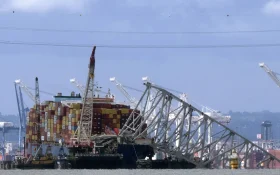Following the collapse of the Francis Scott Key Bridge on March 26, which blocked most maritime traffic into Baltimore’s harbor, the main shipping channel into the port has fully reopened to its original depth and width.
The reopening comes after a massive cleanup effort that involved removing an estimated 50,000 tons of steel and concrete from the Patapsco River.
The bridge collapsed after a container ship, the Dali, lost power and crashed into one of its supporting columns, causing six members of a roadwork crew to fall to their deaths. All of the victims were working an overnight shift to fill potholes on the bridge.
The Port of Baltimore, which is the largest processor of cars and farm equipment in the country, was effectively closed for several weeks while the wreckage was removed. Crews were able to reopen portions of the deep-draft channel in phases, allowing some commercial traffic to resume in recent weeks.
On May 20, the Dali was refloated and guided back to port after being stuck amid the wreckage for almost two months. Following its removal, crews opened a channel that was 50 feet deep and 400 feet wide. The full federal shipping channel, which is 700 feet wide, has now been restored, allowing two-way traffic to resume and lifting additional safety requirements.
The collapse had a significant impact on thousands of longshoremen, truckers, and small business owners whose jobs depend on the busy port. Local and state officials prioritized reopening the port and restoring its traffic to normal capacity to ease the economic ripple effects.
A total of 56 federal, state, and local agencies participated in the salvage operations, including about 500 specialists from around the world who operated a fleet of various vessels and equipment. Col. Estee Pinchasin, Baltimore district commander for the Army Corps of Engineers, expressed pride in the team’s accomplishments and acknowledged the loss of the victims’ families.
The Dali lost power shortly after leaving Baltimore for Sri Lanka on March 26, and investigations by the National Transportation Safety Board and the FBI are ongoing to determine the exact causes of the electrical issues and the circumstances leading up to the collapse.
Officials hope to rebuild the bridge by 2028.
The Associated Press contributed to this article.
